|
|
Chamant

|
|
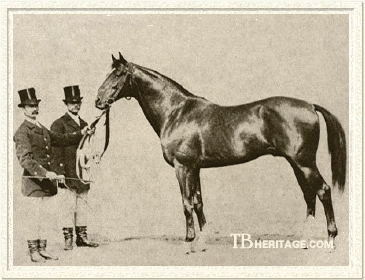 |
|
|
The French-bred Chamant, whose only races were in Great Britain and lasted less than 1-1/2 seasons, became an extremely influential stallion in Germany. He was the grand French stayer Mortemer's best sire son, and he was the one to continue Mortemer's sire line, although it was only successful for another generation. A number of his daughters, and those of his sons, became important German matrons still seen tail-female in thoroughbred pedigrees today. Chamant and his full and half-bred sons were also well-used as sires of half-bred horses in the German state studs, and despite ravaging illnesses and wars, his distant warmblood descendants, notably the Trakehners, are seen competing in show rings today.
His sire, Mortemer (1865), one of the great French stayers that was brought to England to race by the Comte Frédéric de Lagrange, was bred at de Langrange's Haras Dangu. He was by Compiegne (1858, out of imported Maid of Hart by The Provost), a son of Fitz-Gladiator, the latter an influential French stallion that continued the Gladiator branch of the Byerley Turk sire line in France. Compeigne was a good stayer whose wins included the Prix du Cadran. He barely got a start at stud before he died at age seven, but he left Mortemer, who continued the sire line.
Mortemer's dam, Comtesse, by The Baron, or Nuncio, won the Derby Continental at Gand for de Lagrange; she also produced a half-sister to Mortemer, Nemea, a winner of the Prix Biennal (Prix Jean Prat), the Prix de la Foret, and the Newmarket October Handicap.
Mortemer, a big 16.2 hands, handsome chestnut, ran between the ages of two and six, winning 23 of his fifty starts in England and France, getting better as he aged. He won the Prix de la Seine three times, the Prix de l'Emperor, la Coupe de Deaville, and other good races in France, and in England his wins included the Stockbridge Gold Cup and Ascot Gold Cup. Mortemer, purchased before his last year of racing by Claude-Joachim Lefèvre, was among the leading sires in France in his first few years at stud, bolstered by his French-bred progeny's earnings in England. At age fifteen he went to Pierre Lorillard's Rancocas Stud in New Jersey, where he got the champion filly Wanda, Exile, and other good horses; when Lorillard took a half-dozen Mortemer grandchildren to race in England, they put him ninth on the leading broodmare sires list in that country, and he was also a leading sire of broodmares in the U.S.
Mortemer retired first to Haras Dangu, which had been leased by Lefèvre, and in 1873 was moved to Lefèvre's newly established stud, Haras de Chamant, near Senlis. There he covered Araucaria (1862, by Ambrose, an unraced son of Touchstone), and in 1874 she dropped Chamant. Araucaria, the last foal of the significant English matron, Pocahontas, was bred and raced by Brownlow Cecil (11th) Earl of Exeter. Araucaria had won one race -- a ten furlong plate at Stamford -- in seven starts at age three. In the stud of Richard Naylor at Hooton Park, near Chester, she had bred five live foals; the best of these on the turf was Wellingtonia (1869, by Chattanooga), that won just a couple of races, but later in France got two classic winners. In 1872 she was purchased, in foal to Macaroni, by Lefèvre, and in 1873 at Haras Chamant in France dropped Camélia, who would win England's One Thousand Guineas and dead-heat with another French-bred and owned filly, Enguerrande, in the Epsom Oaks. Her year-younger half-brother, Chamant, accompanied the stable to England where he had some success as a juvenile. Araucaria also produced Rayon d'Or, by Flageolet, in 1876, a good juvenile in England and at age three a winner of the Doncaster St. Leger and later a leading sire in the U.S., and the unraced Apremont (1878, by Mortemer), that was a leading sire in New Zealand of youngsters of the "soundest of legs" and "high courage."
Chamant on the Turf
In the early 1870s Lefèvre and de Lagrange formed a racing partnership that lasted until 1878, specifically aimed at running their horses in England, which they did very successfully, with Chamant, Verneuil and his sister Clémentine, Saint Christophe, and other good ones. Chamant was a big colt, but he was not as ungainly as many of Mortemer's offspring, and proved to be a very good two-year-old. He was sent to England before his juvenile season started, and was installed with trainer Tom Jennings at Phantom Cottage, Newmarket, and never saw a French racecourse. He ran in de Lagrange's colors.
Chamant ran eight times at age two, and won three of his races. He started in July at Newmarket, where he was unplaced in the July Stakes, with seven in the field. In Goodwood's Lavant Stakes several weeks later he ran second to Shillelagh by 3/4 of a length, with five others in the field. In August he was at Lewes, where he ran unplaced in the Astley Stakes, won by Placida (who would take the Oaks the following year), with ten others in the field, but a day later he won the Priory Stakes by 3/4 of a length, beating seven other youngsters. At Doncaster in September he ran unplaced in the Champagne Stakes, and was third by three lengths in a sweepstakes for juveniles several days later. He hit his stride in October, winning Newmarket's Middle Park Plate by a head (receiving weight), with seventeen others in the field, and two weeks later took Newmarket's Dewhurst Stakes by half a length, with six others running. The latter two wins set him up as a good, if not certain, candidate for the classics. Called a flyer by some, his speed was impressive, but it was not known how far he could extend himself.
He came out at age three for Newmarket Craven's Bennington Stakes, where he took a walk-over. Next up was the Two Thousand Guineas, where he beat American John Sanford's Brown Prince by a length, with Silvio (Derby and St. Leger winner) third, and eight others in the field, but he sprained his back during the running. His connections went ahead and ran him in the Epsom Derby, but he was unplaced, and the back issues, along with an indication that he was developing into a roarer, permanently retired him from the turf. His ability to stay was never tested.
Chamant in the Stud
Chamant went back to Dangu in France, briefly, and in 1878 was purchased for £4,000 by Georg von Lehndorff for the German Imperial Stud at Graditz. His purchase was not popular with German breeders, who were more inclined to favor stayers as stallions at that time, and there was concern regarding his roaring, although as it turned out, he did not pass on that defect. In addition, all things "French" were extremely unpopular, due to the Franco-Prussian war of 1870, still fresh in the minds of all Germans.
Chamant was not the first thoroughbred to stand at Graditz, but he was the first truly influential stallion in Germany. First, he broke the hold the Hungarian-based (although English-bred) stallions Buccaneer and Cambuscan had on central European racing (Austria, Hungary, Germany). Second, he was leading sire in Germany six times; between 1885 and 1887, and again between 1890 and 1892. Up to 1898, the year of his death, his progeny had won over £150,000, including all the German classics -- despite periodic attempts by the Union Club (private German breeders) to exclude Graditz-bred horses from racing completely or by handicapping them with outrageous weights -- and important races in Austria and Hungary. Third, his son, SAPHIR, continued the Mortemer sire line by leading the sire's list three times in 1904, 1905 and 1907, and he got other useful sire sons in both state studs and private studs. Fourth, he got many good daughters that were immediately successful producers, and his sons, especially SAPHIR, were the sires of mares that made notable contributions to thoroughbred bloodstock in Germany. His great success as a stallion in Germany influenced the Hungarians, who began to look at French, rather than English, stallions to purchase for the imperial and private studs.
But Chamant, and other thoroughbred stallions, were not purchased by the government to solely, or even primarily, to elevate horse racing in Germany. They were intended to improve light horse breeding generally, and cavalry horses in particular, and after 1892 Chamant served at the Imperial stud at Beberbeck, where he got a number of half-bred fillies and colts, and where he was kept in shape: "As long as Old Chamant was in Beberbeck he did his canters daily up to his 20th year."
These Beberbecks found their way into other breeding programs, now referred to (historically) as Beberbeck, East Prussian and (historically and contempory) as Trakehners and Westphalians. His half-bred sons and daughters are seen in contemporary Westphalian and Trakehner -- now sport horses that excel in dressage and jumping -- pedigrees through multiple lines in influential stallions, such as Pregel (1958) and Impuls (1953). Chamant's thoroughbred son, CICERO (1882, out of Liane, by Blenheim), bred at Graditz, never saw a racecourse, but was used extensively as a stallion to improve half-breds in East Prussia; likewise, PANTHER (1886, from Pulcherrima by Beadsman) went to the government stud at Trakehnen, where he was used as an improvement stallion, and PANTHER'S half-bred grandson, Roemer can be seen in some Westphalian and Trakhener pedigrees. Another Chamant son, LEHNSHERR (1889) got Emporer (1899), a stallion at the government stud at Trakehnen, seen in Pregel's pedigree. A number of other Chamant sons, both full-bred and half-bred, were stallions at the various breeding depots established throughout the country, open to public mares and intended to raise the general quality of German horses.
|
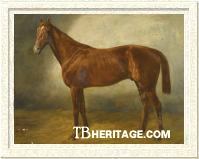
Saphir
| | The big handsome chestnut SAPHIR (1894), who looked a lot like his grandsire, Mortemer, was out of Sappho (1886, by Wisdom), that had won Baden Baden's Zukunfts-Rennen. He was Chamant's best sire son, topping the sire's list in Germany three times -- 1904, 1905, and 1907, and near the top for most of his stud career. He was bred at Gestüt Schlenderhan, near Cologne. The stud had been established by Eduard von Oppenheim, member of a long-established German banking family, in 1869, and is today the oldest privately-owned stud in the country -- its ownership by the Oppenheim family was briefly interrupted by confiscation by the S.S. in World War II, but rebuilt afterwards.
|
Von Oppenheim's son, Alfred, bred such great German horses as Oleander, Prunus, Wallenstein -- all leading sires -- and the unbeaten champion runner Alba, and his grandson, Waldemar, bred five Deutsches Derby winners, among them the spectacular filly Schwarzgold, Sturmvogel, and Magnat. From its inception, a powerhouse stud in Germany, Gestüt Schlenderhan was the dominant breeding operation of the 1930s, with numerous winners descended from SAPHIR daughters.
SAPHIR only raced four times, although undefeated, "like a blazing meteor he soared into the heavens of the turf, and then as suddenly went out in darkness." Because he was, like his grandsire, big and growthy, he was limited to two starts as a two-year-old: he won the Austria Preis, a much more significant event than his German juvenile win, the Rennard-Rennen at Hoppegarten. At three he won the Jubiläums-Preis at Hoppegarten. He was so good, von Oppenheim agreed to run him in Austria again, then a much more competetive and higher class venue than anything in Germany, as a prelude to what was believed to be the beginning of a brilliant season. He became the first German-bred to win the Österreichisches Derby since Oppenheim's Good Hope had taken it almost twenty years previously, but it was a tragic victory. Sixty yards before the winning post in the Derby his right fetlock gave way, but his jockey whipped him every stride after to put him first. Just past the post, his left fetlock, bearing all his weight, also failed, and he fell. It was a terrific show of courage on the part of the horse, and a horrific show of jockey judgement; his owner, Eduard von Oppenheim, "...on hearing of his victory and the damage done to his horse, is said...to have burst into tears."
Completely broken-down, SAPHIR was returned to the place of his birth for stud duty. He got many winners, including Désir (1904, out of Gold Dream), a winner of the Ratibor-Rennen and Deutsches Derby for the Weinberg brothers of Gestüt Waldfried, and Gestüt Schlenderhan's Marmor (1915, out of Mahalla), a winner of nine races (and four placings) in seventeen starts, including the Deutsches Derby, the Hansa Preis and the Grosser Preis von Hamburg. Neither these, nor any other of his sons were able to continue the sire line, but many of his daughters, a number of which were returned to Gestüt Schlenderhan after their turf careers, were important German matrons.
SAPHIR's other classic-winning sons included: Bengali (1900, out of Uccella by Ayrshire) and Roi Soleil (1912, from Royal Maze by Royal Hampton), both winners of the Henckel-Rennen (German Two Thousand Guineas); and Royal Blue (1909, brother to Roi Soleil), who took the Deutsches St. Leger and the Alexander Rennen, among other races.
SAPHIR was also the sire of Mon Désir (1902, out of Desiree by Velasquez, a half-sister to Dark Ronald), who won the Preis der Diana for von Oppenheim. She became a foundation mare at Gestüt Schlenderhan, as did many of SAPHIR'S daughters; a great deal of in-breeding can be seen in the Schlenderhan female lines. Mon Desir's daughter, Dirndl (1922, by Dark Ronald, and fairly closely in-bred), won the Hammonia Preis. Her daughter, Wunschelruthe (1916, by Nuage) was second dam of Widerhall (1929, by Prunus, by Dark Ronald), winner of the Grosser Preis von Baden, Henckel-Rennen; Waffenschmied (1931, by Oleander, son of Prunus), whose wins included the Preis des Winterfavoriten; and Wehr Dich (1936, by Wallenstein, son of Dark Ronald with SAPHIR'S daughter Danubia second dam of Wallenstein), 1939 champion German colt whose wins included the Deutsches Derby, Henckel-Rennen and other races, all bred at Schlenderhan.
Blaustrumpf (1905, from St. Alvere by Hermit) was SAPHIR'S best daughter on the turf. She won fifteen of her 44 starts, including the Preis der Mark, the Preis von Schlesien, the Grunewald Rennen and the Falkenhausen Rennen. She produced Blaue Blume (1923, by Fels), a winner of two races and an excellent broodmare that was the dam of ten winners -- including Blaue Adria (1939, by Ladro), champion juvenile in Germany and Union Rennen winner Blasius -- and established a successful female line in Germany still active today.
SAPHIR'S daughter Farandole's (1902, out of Franche by Comte) wins included the Hertefeld-Rennen at age three, and at age four the Hohenloe Oehringen-Rennen, the Preis der Stadt at Baden-Baden, and Köln's Preis von Donaueschingen. Through daughter Frauenlob (1915, by Caius). a winner of the Rheinisches Zucht-Rennen, she was second dam of Ferro (1923), champion three-year-old in Germany and later a successful stallion.
SAPHIR'S daughter Danubia (1902, out of Austria, by Ayrshire) won the Saphir Rennen and other races for von Oppenheim, and was later one of Gestüt Schlenderhan's important foundation mares. Her son Danilo (1908, by Caius) won the Austria Preis and Rennard-Rennen, among other races; Csardas (1910, brother to Danilo), took the Österreichisches Derby and the Henckel-Rennen, and Dolomit (1909, by Ard Patrick) was the champion runner in Germany in 1911, winner of numerous races, including the Grosser Preis von Hanover, the Jubiläums-Preis, the Grosser Preis von Hamburg, the Grosser Preis von Berlin, and many other races. Danubia's daughters included Wiener Madel (1911, by William the Third), the dam of a series of excellent runners and useful bloodstock, including Wallenstein (champion runner in 1922, and leading sire in 1930, based at Gestüt Schlenderhan) and Weissdorn; Dolly (1915 by Dark Ronald), dam of Preis der Diana winner Dornrose (1932); and Die Woke (1918, by Nuage), dam of Deutsches St. Leger and Fürstenberg-Rennen winner Wolkenflug (1928).
Other good broodmare daughters by SAPHIR included Cambridge (1911, out of Chain Stitch by St. Serf), the dam of Chrysolith (1918), a winner of the Fürstenberg-Rennen, and Isolde (1910, out Ibidem ( a Preis der Diana winner)), a winner of the Ard Patrick Rennen and the Eintracht Rennen, and placed third in the Preis der Diana and three other races in eleven starts at ages two and three. Isolde, another Schlenderhan matron, bred six winners of thirty-seven races; a son, Impressionist (1923, by Prunus), won the Grosser Hansa Preis and other races, and her daughter, Isabella (1919, by Majestic) was the dam of 1929 German champion racehorse Graf Isolani (1926, by Graf Ferry), a winner of the Deutsches Derby, Deutsches St. Leger, Union-Rennen, and other important races. SAPHIR'S in-bred daughter Germania (1905, out of Lady Gay Spanker by PETER) won the Preis der Stadt Düsseldorf, and was later dam of German (1918), a winner of the Svenski Derby.
Other SAPHIR winners included: Baron (1900, Blank Day by Enterprise), winner of Dresden's Grosser Sachsen-Preis; For Ever (1905, out of Flirt by Saraband), a winner at two of the Preis der Winterfavoriten and the Alexander-Rennen and at three of the Grosser Hansa Preis and Grosser Preis von Berlin; Hapsburg (1901, brother to Danubia), winner of Köln's Preis von Rhein and the Grosser Preis von Hamburg; Granit (1901, out of Esterel), winner of the Grosser Preis von Hannover and other races; the in-bred Signor (1900, out of Nora, by PETER), a winner of the Grosser Preis von Berlin, his gelded brother, Normanne (1901), winner of the Gorsses Hoppegartener Handicap, the Germania Preis, and other races over fences, and Signorina (1906, later a Schlenderhan matron), a winner of the Espoir-Handicap at Hamburg and Baden-Baden's Preis von Karlsruhe and Kincsem-Rennen; Slicker (1901, from Sly by Strathconan), winner of Baden-Baden's Schwarzwald-Rennen and the Grosser Preis von Leipzig, among other races at ages two and three; the gelded Michael (1899, out of Michaela), winner of the Grosser Preis von Leipzig and other races through age eight; Sokrat (1906, out of Rose Pompon by Beauminet), who won the Gosudaryni Imperatricy in Moscow; Schlenderhan's Skarabae (1915, from Shamrock, by Bay Ronald), a winner of the Ratibor-Rennen and third dam of Deutsches St. Leger winner Samurai (1937).
|
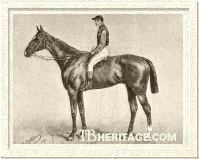
Dorn
| | Chamant's son DORN (1883), champion German horse in 1892, was out of Miss Gorse (by Constanz), bred at Gestüt Schlenderhan by Eduard von Oppenheim; Miss Gorse was out of the King Tom mare, Gorse (1872) that had been purchased by Oppenheim and was a significant foundation mare at Schlenderhan. In addition to Miss Gorse, Gorse had produced Good Hope, Oppenheim's Österreichisches Derby winner of 1873 and a number of other horses, including Goura, dam of Preis der Diana winner Glocke (1880, by The Palmer), and GEHEIMNISS (1865) by Chamant. DORN'S dam, Miss Gorse, also produced his full sister, SCHOTTLAND (1891), dam of the dual-classic winner Real Scotch (1901) and also an important Schlenderhan matron.
|
A big bay colt with his sire's roman nose, DORN was Chamant's best runner. His wins at age three included the Henckel-Rennen (Hoppegarten, Two Thousand Guineas, beating seven others), the Union-Rennen (Hoppegarten, 1-3/8 miles), the Grosser Preis von Hannover, the Deutsches St. Leger (Hannover, 1-3/4 miles), the Staatspreis (First Class) at the Hoppegarten, the Grosser Pres von Berlin (Hoppegarten), and the Hertefeld-Rennen (Hoppegarten, 1-7/8 miles); the only important race he did not win that year was the Deutsches Derby, won by the Hungarian horse Espoir (by Barcaldine), where he ran third, with ten in the field. At age four his wins included the Grosser Hansa-Preis at Hamburg (1-1/4 miles), the Hohenlohe-Oehringen-Rennen at Hoppegarten, and the Hoppegartener Jubiläums-Preis.
Retired to Schlenderhan, DORN was just a useful stallion. He got Don Jose (1897, from Micaela by Beaudesert), a very good juvenile winner of the Zunkunft's Rennen (Baden-Baden), the Hoppegarten's Renard-Rennen, and the Ratibor-Rennen. DORN was also the sire of Semiramis (1898, out of Sappho, by Wisdom, and so half-sister to SAPHIR), winner of the Preis von Köln and the Rheinisches Zucht Rennen and two other races in fifteen starts at ages two and three. Semiramis, a Schlenderhan matron, was later the dam of nine winners, including Sieger, an excellent juvenile winner of the Hamburger Criterium, the Siestorpff-Memorial at Hoppegarten, the Graf Johannes Renard-Erinnerungs-Rennen (Breslau), and the Rheinisches Zucht-Rennen at Köln, among other races. At age three Sieger (1905, by Hannibal) won the Deutsches Derby and several other races for von Oppenheim. Other Semiramis offspring that won included Smart (1908, by Caius), whose wins included the Hamburger Criterium and Ausstellungs-Preis at age two; Kriegsgöttin (1911, by Hannibal), winner of the Grosser Preis von Hannover and Hamburg's Hammonia-Preis; and the in-bred Südtiroler (1918, by Dolomit), winner of the Horner-Ausgleich at age six. Semiramis's female line continued with classic winners in Germany through the twentieth century.
DORN'S unraced sister SCHOTTLAND (1891, out of Miss Gorse) was the dam of von Oppenheim's Real Scotch (1901, by Realist), the champion German runner in 1904. His wins that year included two classics -- the Henckel-Rennen and the Deutsches St. Leger -- and the Fürst zu Hohenlohe-Oehringen-Rennen, the Graditz-Rennen, the Alexander-Rennen, Hoppegarten's Staats-Preis (First Class), the Hertefeld-Rennen, the Frankfurter Gold-Pokal, with placings in all of the principal races he did not win.
|
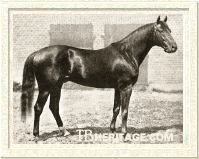
Potrimpos
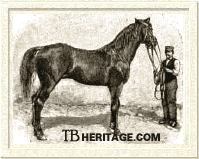
Pumpernickel
| | Pulcherrima (1873) was a very small, weedy filly by Epsom Derby winner Beadsman, and out of the great racemare Formosa (by Buccaneer, before he went to the Hungarian Imperial Stud). Beadsman had already proved himself as a sire of good runners, including Derby winner Blue Gown, St. Leger winner Pero Gomez, and the beautiful, versatile Rosicrucian. Despite her size and useless record, she was purchased on the basis of her pedigree for the German state stud at Graditz by Georg von Lehndorff for the healthy sum of 1,000 guineas, and sent to Germany in 1877. Von Lenhdorff was roundly criticized at the time for the outlay on Pulcherrima -- the government had not yet loosened its purse strings for large sums spent a decade later -- but his judgment proved sound. She bred three German classic winners to the cover of Chamant, and was later considered one of the best mares to ever lodge at Graditz.
The first successful colt from this cross was PICOLLOS (1882), a winner of the Deutsches St. Leger and Staatspreis (First Class) at Hoppegarten. Sold to Count Ludwig Henckel as a stallion, he was not very successful. Next was POTRIMPOS (1883), at the top of his generation, winner of the Preis von Thüringen at Gotha, the Hamburger Criterium, and the Ratibor-Rennen as a juvenile, and the Deutsches Derby and Henckel-Rennen at age three. He got some winners, including Wels (1890) a good juvenile, and Birkhahn (1890), a winner at two of the Renard-Rennen and the Ratibor-Rennen, and at age four the Silberner Schild at Hoppegarten.
|
The third colt from this cross, PUMPERNICKEL (1884), also won the Ratibor-Rennen as a juvenile, and went on at age three to win the Deutsches St. Leger and the Magyar St. Leger. He was a useful stallion, standing for a number of years at Graditz, mostly the sire of good juveniles and milers. His son, Flunkermichael (1894, out of Flora, by Champagne), raced by Count L. Henckel, won the Grosser Hansa-Preis and the Deutsches Derby, placing second to SAPHIR in Austria's Jubiläums-Preis. PUMPERNICKEL'S son Wolkenschieber (1894, out of Wera, by Aaron), was a top juvenile for his breeder, Fürst Hohenlohe-Oehringen. Wolkenschieber won the Ratibor-Rennen, the Sierstorpff-Rennen, the Zukunfts-Rennen at Baden-Baden, and the Hamburger Criterium; at three he was third to Flunkermichael in the Deutsches Derby. Wolkenschieber's sister, Wolkenhuhn (1895), won the Oktober-Preis für Zweijährge at Frankfurt at age two, and was second to Gudrun in the Preis der Diana at age three.
PUMPERNICKEL'S other winners included Romito (1900, from Rhea Silvia by Flibustier), winner of the Leipziger Stiftungspreis and the Zukunfts-Rennen at Baden-Baden; Prinz Hamlet (1899, from Princess Hampton), bred by the Weinberg brothers, a winner at age three of the Union-Rennen, and at age four of the Staatspreis (First Class) at Hoppegarten and the Silberner Schild; Scharb (1897, out of Sharpsand), winner of the GRosser Hamburger Ausgleich; Pulcher (1899), Preis von Thüringen, and Athanus (1890), whose wins included Breslau's Herzog von Ratibor-Erinnerungs-Rennen.
A fourth brother from the Pulcherrima - Chamant cross, PANTHER (1886), was sent in 1890 to the government stud at Trakehnen for use as an improvement stallion for half-bred mares. His grandson, Roemer (1897) had an influence on Westphalian and Trakhener pedigrees.
|

Peter
| | PETER (1888, out of Pearlina, by Brown Bread), was bred at Graditz, and trained, as all Graditz runners were, by Englishman Richard Waugh at the Hoppegarten track near Berlin. He was a useful juvenile that won the Hamburger Criterium, the Graf Hugo-Henckel in Austria, and placed second in the Zukunfts-Rennen at Baden Baden and the Preis von Thüringen at Gotha. At age three he was champion colt in earnings, his wins included the classics Henckel-Rennen and the Deutsches Derby in Germany.
|
| PETER was a modest stallion, sire of St. Pierre, a winner of the 1892 Badener Handicap Steeplechase. A couple of his daughters were good broodmares. Nora (1889, out of Minerva, by Peon) won the Fürstenberg-Rennen and Frankfurt's Wäldchens-Rennen at age three for Eduard von Oppenheim, and was later the dam of Signor (1900 by SAPHIR) and his sister Signorina (1906), both winners (see SAPHIR); Signorina, a Gestüt Schlenderhan matron, established a successful tail-female line that included 1941 champion colt Magnat, bred at Schlenderhan. PETER'S daughter Lady Gay Spanker (1892, out of the imported Gay Duchess by Rosicrucian) was the dam of a number of winners, notably Stossvogel (1906 by Gouveneur), who took the Grosser Preis von Hamburg and was second in the Henckel-Rennen, his sister Lena (1910), winner of the Kincsem-Rennen at Baden-Baden and the Goldene Peitsche at Hoppegarten, and the in-bred Germania (1905, by SAPHIR), a winner of the Preis der Stadt Düsseldorf (over jumps) and later dam of Svenski Derby winner German (1918, by Anschluss). |
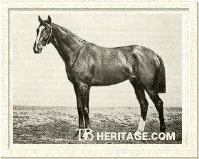
Habenichts
| | The chestnut HABENICHTS (1895, out of Haselnuss, by Flibustier), bred at Graditz and raced by the state stud, won eight of his eleven races at ages two and three. As a juvenile he won Baden-Baden's Zukunfts-Rennen, Hoppegarten's Renard-Rennen, and the Ratibor Rennen. The next year he won the Deutsches Derby and the Grosser Preis von Baden-Baden, among other races.
|
HABENICHTS served as a stallion for the German Breeding Society at Union Gestüt Hoppegarten for several years. His best runner was Pathos (1901, from Ponza, by Springfield), a winner of the Union-Rennen and the Grosser Preis von Berlin at age three, and the Herzog von Ratibor-Erinnerungs-Rennen at Breslau and the Staatspreis (First Class) at the Hoppegarten at age four. His daughter, Generalin (1901, out of Gnädigste, by Escogriffe), a half-sister to Deutsches Derby winner Gulliver II (by Hannibal), was the dam of Grita (1909, by Hannibal, bred at Graditz), a juvenile winner of the Galtee More-Rennen (Hoppegarten), and the Kincsem-Rennen at Baden-Baden, and of a couple of races at age three. Grita's tail-female line continued through the twentieth century.
Chamant's other classic winners in Germany included ANDERNACH (1882, out of Andorka, by Buccaneer), bred and raced by the state stud at Graditz, who took the Henckel-Rennen -- his sister AHENPROBE (1887) won the Hoppegarten's Staatspreis (First Class) at age three; VOLLMOND (1895, out of Vision, by Flibustier), REGENWOLKE (1898, out of Pluie d'Or by Bend Or; and GERANIUM (1894, out of Verbena, by Trappist).
|
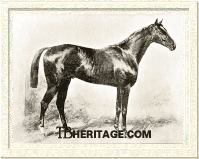
Vollmond
| | REGENWOLKE won the Henckel-Rennen, the Grosser Hansa-Preis, and the Hohenloe-Oehringen-Rennen, but could only run third to the champion Tuki (by Gouverneur) in the Deutsches Derby. VOLLMOND, bred at Graditz, won the Deutsches St. Leger at three, as well as the Silberner Schild, the Union-Rennen, the Hohenlohe-Oehringen-Rennen, Hoppegarten's Staatspries (First Class), Frankfurt's Wäldschens-Rennen, and the Hereteld-Rennen, but was behind stablemate Erbtante (1888 by WELTMANN) in earnings that year. He later got some winners, among them Preller (1901), Girlamund (1901), and Pas de Quatre (1903).
|
WELTMANN (1881, out of Preis der Diana winner Vergissmeinnicht by Savernake, a half-sister to Walhalla, the dam of WALLFAHRT and WALVATER), like VOLLMOND, bred and raced by the state stud at Graditz, won the Ratibor Rennen at two and took the Goldene Peitsche (Hoppegarten) the next year. WELTMANN was later the sire of Glocknerin (1887), a winner of the Norddeutsches St. Leger, and of the excellent filly Erbtante (1886), whose wins at age three, which included the Silberner Schild, the Hertefeld-Rennen, and the Hoppegarten's Staatspreis (First Class), and her second in the Preis der Diana, made her the champion earner in Germany in 1889. WELTMANN, as a stallion at Trakehnen, Graditz and Beberbeck, was also used on half-bred mares to improve cavalry and riding stock; he is still seen in some modern Trakehner pedigrees. WELTMANN'S sister, WEHMUTH (1885) was later the dam of Incroyable (1897, by Stronzian), a winner in Austria-Hungary of the Graf Hugo-Henckel, the Millenniumi dig, and the Alagi dij.
Chamant's son GERANIUM (1894, out of Verbena, by Trappist) was an excellent three-year-old winner of the Deutsches St. Leger, the Herzog von Ratibor-Erinnerungs-Rennen, the Fürstenberg Rennen and the Grosser Preis von Leipzig.
Count Nikolaus Esterházy's Hungarian-bred mare Vita (by Buccaneer) was sent to Chamant at Graditz. To his cover, she produced SOLL ICH (1884), a winner of the Magyar Kanca-dij (Hungarian Oaks). Another Chamant daughter, WALLFAHRT (1885, out of Walhalla, by Rustic, a half-sister to Vergissmeinnicht, the dam of WELTMANN) won the Fürstenberg-Rennen: her sister WEGA (1881) took the Preis von Thüringen as a juvenile, and their brother, WALVATER (1888) won the Renard-Rennen and the Deutscher Gestütspreis as a juvenile, and the Silberner Schild at age three.
Other winning Chamant offspring, all bred at Graditz, included: TRIFTIG (1882, out of Thrifty, by Adventurer), a winner of the Fürstenberg-Rennen and the Goldene Peitsche; HORTARI (1885, from Hamadryade, by Bois Roussel), who took the Ratibor-Rennen as a juvenile and the Hertefeld-Rennen at age three, and his brother, HARTENFELS (1884, seen in Trakehner pedigrees through Trakehner grandson Polarsturm (1900)), a winner of the Silberner Schild; MILCHMANN (1891, out of Milchmadchen, by Dalham), a winner of the Graf Hugo-Henckel at age two and the Goldene Peitsche at age three; POMP (1897, out of Ponza, by Springfield, and so half-brother to Pathos by HABENICHTS) won the Union-Rennen, and is seen in Trakehner pedigrees.
|
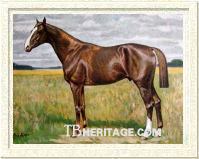
Letzter Mohikaner
| | LETZTER MOHIKANER (1899, out of Lozenge, by St. Simon) was schooled at Newmarket as a juvenile, where he ran once, without winning. In Germany at age three, he won two races in seven starts, the Grosser Preis von Hannover and the Cosmpolitan Handicap at Baden-Baden, and the next year won one of four starts. He was a used on half-bred Trakehnen mares at Graditz, and afterwards took up residence at Braunsberg, used as an improvement stallion, where he stood until he was shot in 1920. A handsome horse with his sire's good temper and a good front-end, and clean legs and joints, he was a bit weak in the hind end. He got a number of half-bred sire sons that were used for Trakehner and East Prussian breeding in local depots, and some broodmare daughters seen in Trakehner pedigrees.
|
ALMENRAUSCH (out of Autonomy, by Isonomy), a Graditz product, won the Renard-Rennen at age two, and the next year took the Herzog von Ratibor-Erinnerungs-Rennen at Breslau and the Grosser Preis von Hannover. His sister, ABENGLOCKE (1895) was the dam of some good winners, including Arnfried (1906, by Hannibal), a winner of the Deutsches Derby; Abendröthe (1905, by Ard Patrick), juvenile winner of Baden-Baden's Hamilton Stakes and Dresden's Jugend-Rennen; and Abendluft (1906, by Hannibal), that at age three won the Goldene Peitsche, the Preis von Rhein, the Kincsem-Rennen at Baden-Baden, and the Oppenheim Memorial at Berlin.
Chamant's Broodmare Daughters
Chamant's daughters produced winners of nine classic races in Germany and one in Austria. Despite their immediate success as broodmares, very few of his thoroughbred daughters established long-lived tail-female lines. However, many of his half-bred daughters from the state stud at Beberbeck had an early influence on warmblood breeds, including the Beberbeck and East Prussian "breeds," the Trakehner, the Westphalian, and, further down the line, the Swedish Warmblood and Hannoverian, and are seen early in the families of various warmbloods. In addition to those noted previously, Chamant's daughters included the following horses.
CHAMOUNY (1881, out of Mandarine, by Mandrake) produced Deutsches St. Leger winner Martigny (1888, by Stronzian), also a winner of the Hertefeld-Rennen.
WARNUNG (1884, out of Willkommen, by The Palmer; Wilkommen was half-sister to Walhalla and Vergissmeinnicht), bred and raced by the state stud, won the Preis von Thüringen at Gotha. Back at Graditz she became the dam of Waschfrau (1892, by St. Gatien), an excellent filly at age three that won the Deutsches St. Leger, the Preis der Diana, the Alexander-Rennen (at Frankfurt) and Dresden's Großer Sachsenpreis.
GEHEIMNISS (1883) was out of Goura, by Buccaneer, also the dam of Eduard von Oppenheim's colt Good Hope and of DORN'S dam, Miss Gorse. Her half-sister, Glocke, won the Preis der Diana. At Graditz, GEHEIMNIS produced a succession of winners, the most notable probably Geier (1890, by Flageolet), who dead-heated with Hardenberg for the Deutsches Derby, and won the Union-Rennen and the Grosser Preis von Hannover. She was also the dam of Gastfreund (1896, by Gouverneur), juvenile winner of the Zukunfts-Rennen, and at age three took the Union-Rennen; Geheimrath (later an important stallion in the Trakehner), who took the Hohenloe-Oehringen-Rennen, Berlin's Jubiläums Preis , and the Friederich Franz-Rennen (at Bad Doberan); the gelded Gerolstein (1904, by Manners), a good steeplechaser that won Berlin's Oster-Preis, Berolina-Jagdrennen and Hoffnungs-Preis, and Goldschaum (1891, by Flageolet), grandsire of Goldschläger I (1909), a Mecklenburger stallion presently one of the most important influences in show jumping bloodlines.
The Wenlock mare, Mocassin (1876), produced two good daughters to the cover of Chamant. MINNEHAHA (1887), who won a handicap at Baden-Baden at two, was the dam of Namouna (1896, by Fulman), juvenile winner of the Renard-Rennen, the Sierstorpff-Rennen, the Hamburger Criterium and the Ratibor-Rennen; the Deutsches St. Leger and Grosser Preis von Berlin at age three, and the Austria-Preis at age four. MINNEHAHA'S other winners included Lobengula (1894, by Fulmen), a winner of the Grosser Preis von Hamburg at age three; Paroli (1898, by Fulmen), who took the Kölner Frühjahrs-Ausgleich; Somali (1901, by Missal), a winner of the Silberner Schild at age three, and Waise (1905, by Fulmen), a winner over fences. Her daughter, Olly (1897, by Fulmen), was dam of Deutsches Derby winner Orient (1907, by Bona Vista, bred and raced by the state stud at Graditz), also a winner of the Grosser Hansa Preis and the Graf Hugo Henckel Memorial. MINNEHAHA'S sister MIRZA (1889), a winner of one race as a juvenile, also a broodmare at Graditz, produced Marabou (1906, by Ard Patrick), champion German runner in 1909 whose wins included the Nickel-Rennen, the Fürst zu Hohenlohe-Oehringen-Rennen, the Grosser Preis von Hannover, the Grosser Preis von Leipzig, and the Magyar St. Leger.
EDELWEISS (1888, from Lady Love, by Blair Athol) was the dam of Bon Marché, bred at Gestüt Nepajedi that ran second to Con Amore in the 1904 Deutsches Derby. Her female line included the outstanding Austrian and Hungarian classic winning mare, Affenblume (1915), and the family continues to the present.
LUCIA (1891, out of Lucretia, by The Palmer) was the dam of Ulrich von Oertzen's Preis der Diana winner, Lore (1898, by Hannibal). Von Oertzen, who spent over twenty years purchasing horses for the Northern German Breeding Society in England, also owned NORDLICHT (1893), third in the Preis der Diana, the dam of Nordlandfaher (1899, by Hannibal), a winner of the Fürstenberg-Rennen. Von Oertzen also bred JUBA (1892), a colt out of Zama (by Hermit), a half-brother to Hannibal, the latter an excellent racehorse and later leading sire in Germany; JUBA'S wins included Hoppegarten's Hohenlohe-Oehringen-Rennen.
Many of Chamant's half-bred daughters at Beberbeck were an early influence on the development of the Westphalian, "East Prussian," Beberbeck, and Trakehner breeds, back when the state studs were developing high-class coaching horses, cavalry horses, and light riding horses. Some female lines persisted through sickness and wars to the present to contribute to the modern versions of these breeds, used as sporthorses. GOLDKIND, a half-bred daughter of Chamant's bred in the 1890s at the state stud at Beberbeck, was second dam of Gärtner, also a stallion at Beberbeck, that was influential in the development of the Westphalian and Trakehner breeds. Another half-bred daughter, GLOCKE (1884), became the dam of Grenadier (1890), another early Trakehner stallion. KORNBLUME (1889) produced Konditor (190-), a winner of the first Goltz-Querfeldein in 1911, and his sister, Kornähre (1904), who bred on, establishing a Trakehner female line. Another half-bred daughter, MAHLZEIT (1893), was third dam of Meleager (1923), an important "Beberbeck" stallion, influential in the Westphalian breed. The half-bred MOSEL (1886) became second dam of Mechanicus, a "Beberbeck" stallion whose offspring were influential in the development of warmbloods in eastern Europe. Half-bred daughter OTTILIE (1880), the dam of the stallion Oktober, is seen in Trakehner pedigrees, including that of Maharadscha (1957), an important modern Trakehner stallion, is also in the pedigree of the Beberbeck stallion Orthopede (in-bred to Chamant through his sire, Machanicus). Chamant's half-bred daughter Sängerin produced the in-bred stallion Sänger (1908, by Pathos by HABENICHS), seen in Trakehner pedigrees. Half-bred daughter THERESINA (1887) was second dam of Titus (1903), a stallion at Beberbeck. Daughter URAKA (1887) established a Beberbeck family. Pregel (1958), another modern Trakehner stallion, has several lines that lead back to both half-bred daughters and sons of Chamant.
Chamant died from heart disease in 1898.
--Patricia Erigero
|
|
|
|

